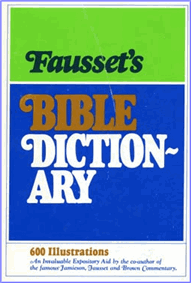Fausset's Bible Dictionary
A B C D E F G H I J K L M N O P Q R S T U V W X Y Z
Crown
A band encircling the head by way of honor; the royal badge of kings; the sacerdotal badge of priests; the prize winner's badge of victory. The Greek diadeema, "diadem" which KJV less fitly translated "crown" in Revelation 12:3; Revelation 19:12. is restricted to Christ the King of kings; Satan wears it only as usurping Christ's right (Revelation 13:1). Stephanos is once applied to His golden "crown" (Revelation 14:14), which refers to Him viewed as a victor, the image being from the wreaths of conquerors in contests. This is also the sense of "crown" in the reward promised to believers who overcome the world, the flesh, and Satan; the "incorruptible crown" (1 Corinthians 9:25); "crown of righteousness," for righteousness will be its own reward (Revelation 22:11; Exodus 39:30; 2 Timothy 4:8).
"Crown of life" (James 1:12; Revelation 2:10; Revelation 3:11), "crown of glory that fadeth not away" as the withering garlands of wild olive, ivy, or parsley, given to the victors in the Isthmian and other games (1 Peter 5:4). The priests' miter was a linen crown or fillet. The mitsnepheth or linen tiara of the high priest was preeminent in splendor (Leviticus 8:9). A "blue (the color of heaven) lace" fillet was underneath, and the golden plate graven with "Holiness to the Lord" on the front of the miter (Exodus 28:36-38; Exodus 28:40). In Ezekiel 21:26, "remove the diadem (mitsnepheth), and take off the crown" ('atarah), i.e. remove the miter, the last Jewish king Zedekiah's priestly emblem, as representing the priestly people.
The "miter" elsewhere is always used of the high priest; but the anointed king partook of the priestly character, from whence his "diadem" is so-called (Exodus 19:6; Exodus 28:4; Zechariah 3:5); also the crown, the emblem of the kingdom; until they be restored and united in the Mediator Messiah (Psalm 110:2; Psalm 110:4; Zechariah 6:13). Gold was the chief material of the king's crown (Psalm 21:3); compare 2 Samuel 12:30, the Ammonites' crown, with its precious stones, was worth (rather than "weighed") a talent of gold. Those feasting at banquets wore "crowns" or wreaths. Compare Isaiah 28:1; Isaiah 28:5; "woe to the crown of pride, to the drunkards of Ephraim, whose glorious beauty is a fading flower"; Samaria, Ephraim's capital on the brow of a hill, is the proud crown of his drunkards; it shall perish as the flower crown on his drunkard's brow soon "fades"; but "the Lord of hosts (in striking contrast) shall be for a crown of glory and for a diadem (tsephirah), splendid head-dress) of beauty unto the residue (the remnant left after consuming judgments) of His people."
The Jews boast of three crowns: the law, the priesthood, the kingly crown. Better than all, a good name. So "crown" is used figuratively (Proverbs 12:4; Proverbs 14:24; Proverbs 17:6; 1 Thessalonians 2:19). "Crown" is used in the sense of the projecting rim round the top of an altar or a table (Exodus 25:25; Exodus 30:4; Exodus 37:27). Christ's "crown of thorns" has been supposed to have been made of the Ramnus nabeca (Hasselquist) or the Lycium spinosum, probably the latter (Sieber). To mock rather than to pain Him was the soldiers' object, and they took whatever came to their hand first. The dark green was a parody of the triumphal ivy wreath.
Bibliography Information
Fausset, Andrew Robert M.A., D.D., "Definition for 'crown' Fausset's Bible Dictionary".
bible-history.com - Fausset's; 1878.
Copyright Information
© Fausset's Bible Dictionary
Fausset's Bible Dictionary Home
Bible History Online Home
Bible Encyclopedia (ISBE)
Online Bible (KJV)
Naves Topical Bible
Smith's Bible Dictionary
Easton's Bible Dictionary
Schaff's Bible Dictionary
Fausset's Bible Dictionary
Matthew Henry Bible Commentary
Hitchcock's Bible Dictionary

Dr. A.R. Fausset
Popular and Trending:
Meaning and definition of fasting, what is fasting in the bible, fasting definition, why should I fast, the power of prayer and fasting, Location of Galilee, where was galilee in the bible?, fasting definition, Galilee region, cities of Galilee, Sea of Galilee, Definition of biblical fire, what is fire in the bible?, fire and brimstone, fire meaning, baking bread with fire, Definition of the biblical firmament in Genesis, what is the firmament in the bible?, was the firmament the third heaven, firmament meaning, did the firmament bring the flood of Noah?.
